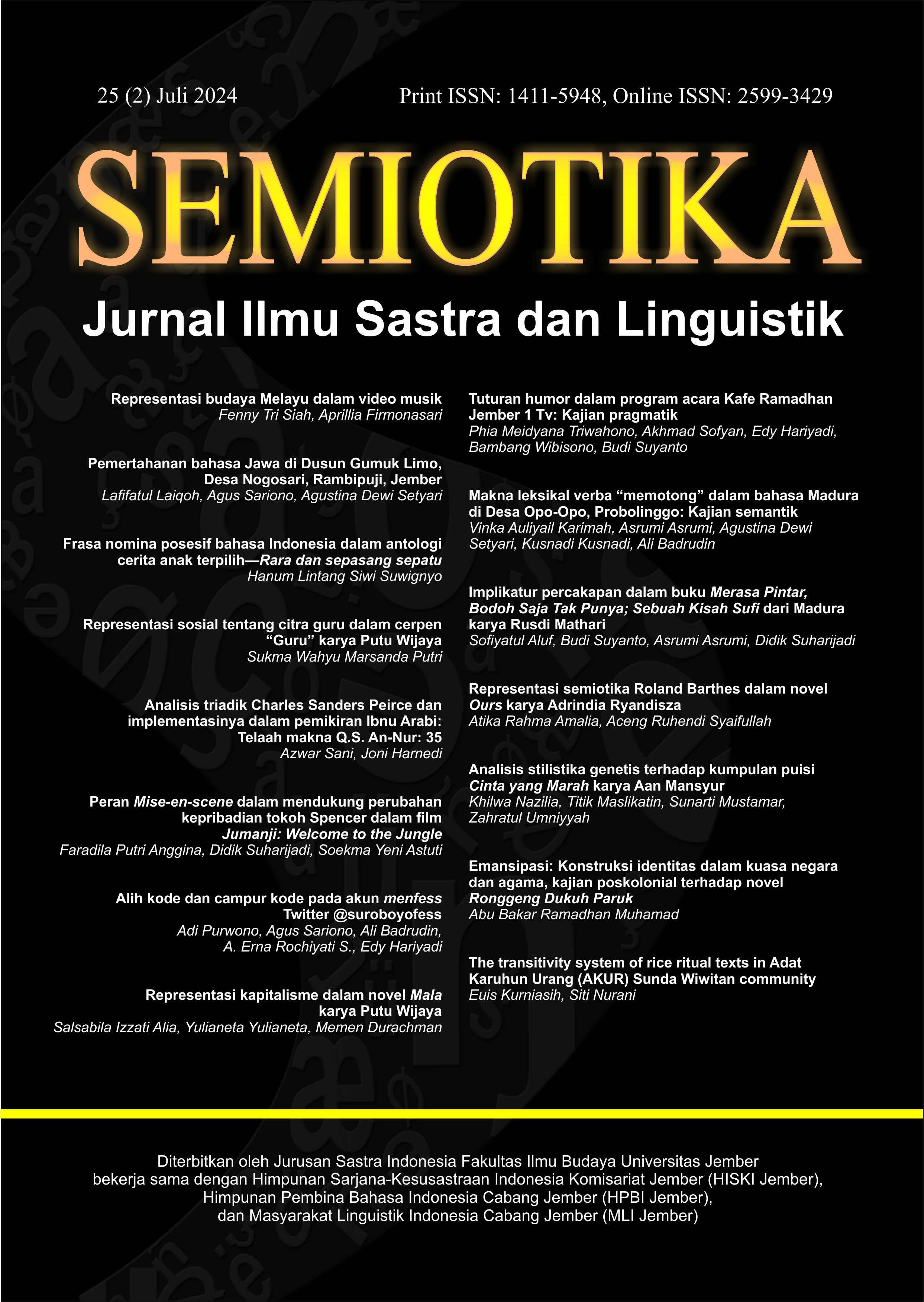Representasi budaya Melayu dalam video musik
Abstract
This research is a qualitative descriptive study with song lyrics and audio-visual activities in music videos as codes for the object of research. The observation method is conducted to collect the research object which is further analyzed based on semiotic studies by applying Umberto Eco's theory. This study aims to classify the code and describe the relationship between content and expression in the code in order to understand the intentions of the songwriters represented through the embodiment of Malay culture. The result shows songs lyrics, music, traditional customs, nature, traditional house, and accessories as a code containing content and expression to represent Malay culture. The connection between content and expression found in this research shows difficilis ratio which requires encyclopedia and understanding to understand the the intentions of the songwriters.
References
Alipya, R., & Nurfauziyah, D. I. (n.d.). “Pesan-Pesan Motivasi dalam Lirik Lagu “Diri” Karya Tulus: Analisis Semiotika.”
Amir Karim, M. (2020). “Analisis Nilai Motivasi dalam Lirik Lagu “Meraih Bintang” Karya Parlin Burman Siburian (Analisis Semiotika De Sausure).” Jurnal Muara Ilmu Sosial, Humaniora, dan Seni, 4(2), 402. https://doi.org/10.24912/jmishumsen.v4i2.8821.2020.
Harnia, N. T. (2021). “Analisis Semiotika Makna Cinta pada Lirik Lagu “Tak Sekedar Cinta” Karya Dnanda.” Jurnal Metamorfosa, 9(2), 224–238. https://doi.org/10.46244/metamorfosa.v9i2.1405.
Hermawan, G.S. (2013). “Jpop: Fenomena Englishization dalam Lirik Lagu Berbahasa Jepang,” Semiotika, 4(1):102—109. https://doi.org/10.19184/semiotika.v14i1.30112.
Lutfi, M., & Zaidan, N. A. (2022, February 9). “Eksistensi Budaya di Tengah Generasi Milenial.” Bhaskara.Id. https://bhaskara.id/eksistensi-budaya-di-tengah-generasi-milenial/ [diakses 12 Januari 2024].
Nathaniel, A. & Sannie, A.W. (2018). “Analisis Semiotika Makna Kesendirian pada Lirik Lagu “Ruang Sendiri” Karya Tulus,” Semiotika, 19(2):107—117. https://doi.org/10.19184/semiotika.v19i2.10447.
Nugroho, A. (2017). Komunitas Sastra Jawa: Penciptaan, Penerbitan, dan Pergelaran Tembang Macapat,” Semiotika, 18(2):168—180. https://doi.org/10.19184/semiotika.v18i2.6540.
Putra, D. K. (2019). “Meneguhkan Melayu di Abad Milenial.” https://artikula.id/dharmakp/meneguhkan-melayu-di-abad-milenial/. [diakses 12 Januari 2024].
Sanusi, I. (2017). “Globalisai Melayu: Peluang dan Tantangan Membangun Identitas Melayu dalam Konteks Modernitas.” 01.
Sara G., B., & Randall E., A. (2017). The Philosophy of Umberto Eco. The Library of Living Philosophers.
Sunandar. (2015). “Melayu dalam Tantangan Globalisasi: Refleksi Sejarah dan Berubahnya Sistem Referensi Budaya.” Jurnal Khatulistiwa – Journal of Islamic Studies, 5, 60–73. https://doi.org/10.24260/khatulistiwa.v5i1.266.
Thamrin, H. (2018). Antropologi Melayu (1st ed.). Kalimedia.
Trinanda, E. R., & Abidin, S. (n.d.). Analisis Semiotika dari Lirik Lagu “Esok Kan Bahagia” yang Dipopulerkan Oleh Group Band D’masiv.
Umberto, E. (1976). A Theory of Semiotics. Indiana University Press.

This work is licensed under a Creative Commons Attribution-ShareAlike 4.0 International License.
SEMIOTIKA has CC-BY-SA or an equivalent license as the optimal license for the publication, distribution, use, and reuse of scholarly work. Authors who publish with this journal retain copyright and grant the journal right of first publication with the work simultaneously licensed under a Creative Commons Attribution-ShareAlike 4.0 International License that allows others to share the work with an acknowledgment of the work's authorship and initial publication in this journal.
Attribution-ShareAlike
CC BY-SA










